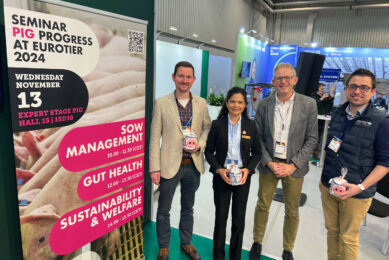On-demand: Webinar on gilt management

Gilt management was the topic of a Pig Progress webinar that was held on June 13. Key question was how gilts can be properly managed and prepared for their role, so producers can profit from a long-lasting and thriving sow herd. The webinar is now available for re-viewing for free.
To view the webinar, click here
The webinar featured 3 expert speakers and was held in cooperation with animal nutrition company DSM-Firmenich.
Future genetics from Denmark
Martin Mølgaard Pedersen is head of the department of breeding and genetics at the Danish Agriculture & Food Council. DanBred is the organisation’s sales vehicle. Topic of his presentation was “DanBred genetics in the future.”
Mølgaard Pedersen concluded by saying that it is essential to aim for more robustness in the genetic work. For that reason, gilts should not be fed ad lib in the rearing phase. He also summed up various goals to achieve at 1st service in 2nd heat:
Age 220-240 days;
Backfat 13-15 mm;
Weight 140-160 kg;
Uniform gilts.
Derisking gilt preparation
Live in the studio was the Matthias Wiemann, technical services manager Germany at DSM-Firmenich. He spoke about “Derisking gilt preparation by focusing on immune competency, bone development and reproductive health.”
Mentioning that gilts are changing fast due to genetic selection. Therefore he pointed to an adjustment of gilt preparation, with a key for sow longevity, production efficiency, welfare and income. He then discussed the role of mycotoxins as endocrine disruptors in this process, as well as the pivotal role of vitamin D nutrition.
Nutritional approach to preparing gilts
Last speaker in the webinar was Dr Jeru Abelilla-Mesina, swine technical expert manager for ASEAN at DSM-Firmenich. In her presentation called “An adaptative nutrition approach to preparing and protecting gilts,” she continued where her colleague Matthias Wiemann had finished.
She explained how the company’s products Hy-D (a vitamin D metabolite) as well as Mycofix (a portfolio to tackle mycotoxin issues) jointly can help support gilt health, by improving bone health, immune competency, reproduction and aspects like growth, gut integrity and feed intake.











